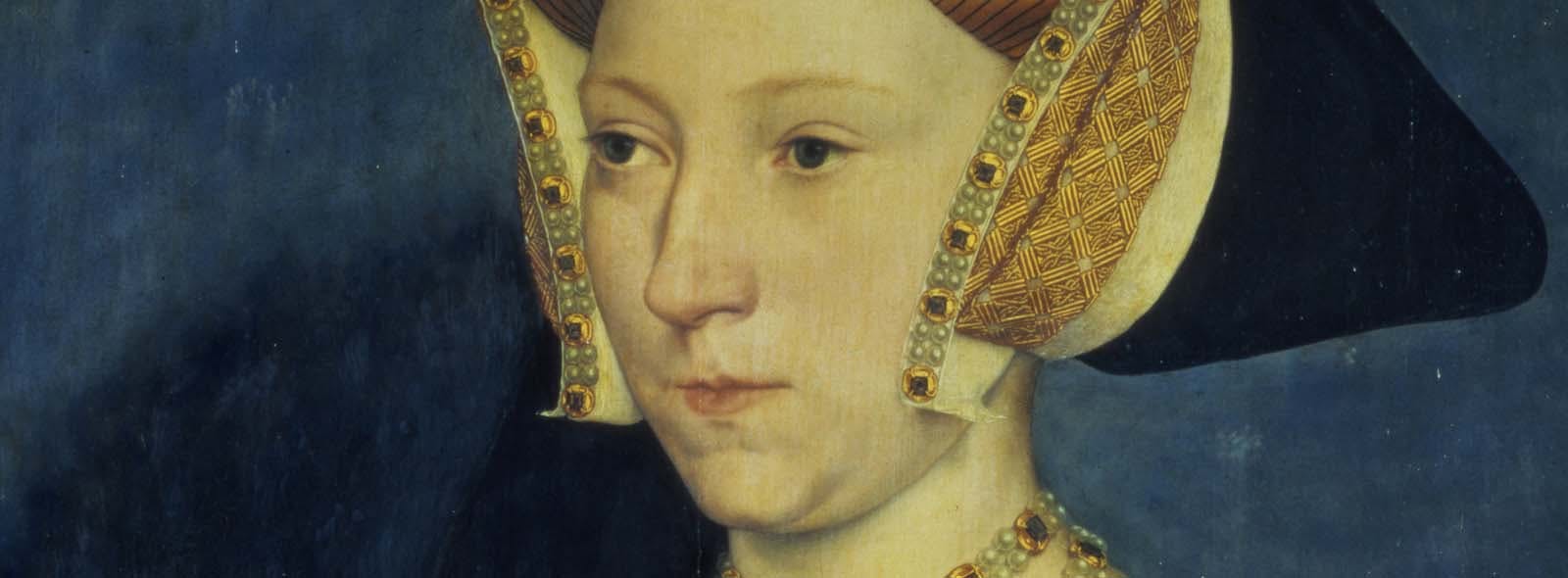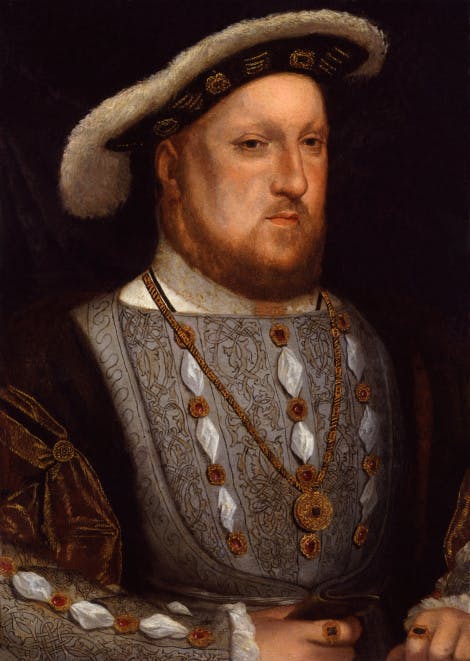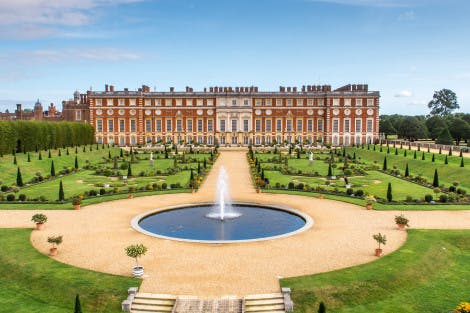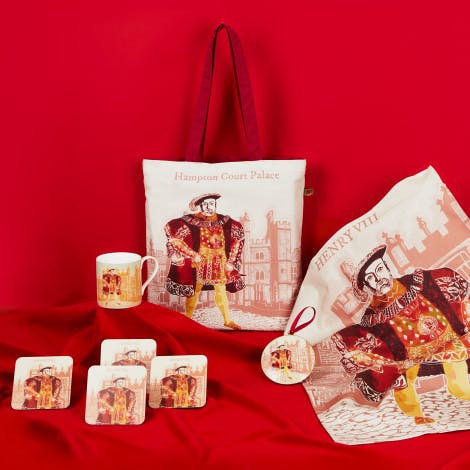
Jane Seymour was Henry VIII’s third wife and Queen. Married for just under a year and a half, Jane is best known as the mother of Edward VI, Henry’s long-awaited son and heir. She died just 12 days after giving birth to her son at Hampton Court Palace.
Some historians have cast Jane as a passive, demure figure - the opposite of her predecessor, the ambitious and out-spoken Anne Boleyn. Yet Jane's dramatic rise from lady-in-waiting to Queen of England suggests there is more to her than meets the eye. Was this quiet and obedient façade a careful tactic to navigate life with the infamous Tudor King?
Perhaps the most elusive of Henry’s six wives, Jane’s short time as Queen offers a tantalising glimpse into the woman behind the King’s only legitimate, surviving son.
Image: Jane Seymour by Hans Holbein the Younger © Bridgeman Images

Image: Jane Seymour after Hans Holbein the Younger circa 1537. © National Portrait Gallery, London
Early life
Born in around 1508-9, Jane Seymour was the eldest daughter of Margery Wentworth and Sir John Seymour. Though her family were respectable lower gentry, Jane's mother was descended from King Edward III and related to two of Henry VIII’s queens — Anne Boleyn and Catherine Howard.
We know very little about Jane’s early life. One of 10 children, she probably spent most of her childhood at Wolfhall, Wiltshire. Here, she learned to read and write, and was taught needlework, music, and household management — all skills expected of an English noblewoman.
Jane arrives at Henry VIII's court
Jane Seymour arrived at court in around 1529, where she entered the service of Katherine of Aragon, Henry VIII's first Queen. As lady-in-waiting, Jane spent her time with other women in Katherine’s entourage, entertaining and attending to the Queen’s needs.
This was a turbulent time for the royal household. Henry was desperate for a male heir, but the royal couple only had one surviving child – a daughter, Princess Mary.
Henry wanted to divorce Katherine and marry Anne Boleyn, another of the Queen's ladies-in-waiting. Henry hoped Anne would have a son to secure the Tudor dynasty.
The new Queen Anne
By 1531, Jane was already swept up in the brewing royal drama. Henry broke ties with the Catholic church and banished Katherine from court. He married Anne in 1533 and Jane soon found a place in her household.
The new Queen Anne was outspoken and put herself at the centre of Henry’s religious reforms. As one of her ladies, Jane would have to put aside her own beliefs, as well as any loyalty towards Katherine.
Jane may have been with Anne as she prepared to give birth (to a daughter, the future Elizabeth I) in September 1533. She likely witnessed Anne’s struggle to deliver the King’s male heir first-hand.
Jane and Henry
It’s not clear when Jane Seymour first caught Henry’s eye. In 1534, the Spanish Ambassador Eustace Chapuys described an affair between the King and an unnamed woman in Anne’s household. Some historians think this might be Jane Seymour, though the lady’s identity remains unknown.
In 1535, Henry and Anne visited the Seymour family seat at Wolfhall, but we don’t know if Jane was present.
It’s difficult to say how Jane felt about Henry or possibly becoming queen. Nonetheless, conservative figures at court would come to recognise Henry’s interest in her and help place Jane before the King.
The Beginning of the end for Anne Boleyn
By 1536, the royal relationship had grown stormy. In January, Anne experienced a miscarriage — one of at least two since the birth of Princess Elizabeth. This time, the child was a boy. Henry's eye continued to wander.
Sensing discord, many at court conspired to remove Anne from power. This included Henry’s Chief Minister and Anne’s former ally, Thomas Cromwell.

Image: Queen Jane Seymour (1508/9-1537) c.1536-7. © Royal Collection Enterprises Limited 2024 | Royal Collection Trust
Henry VIII courts Jane Seymour
Gifts from the King
In March 1536, the King sent Jane a letter, along with a generous purse of gold sovereigns, as a token of his affection.
But Jane refused the gift, kissing Henry’s unopened letter and asking the messenger to return it. According to Chapuys, Jane replied that she could not accept the letter as there was ‘no treasure in the world that she valued as much as her honour’. If the King wanted to send another gift, she suggested he might wait until ‘such a time as God would be pleased to send her some advantageous marriage’.
This was a clever move. Anne Boleyn had also refused the King’s affections, which only stoked Henry’s obsession with her.
The Seymours move into Greenwich Palace
Impressed by Jane’s modesty, Henry moved her elder brother, Edward Seymour into Thomas Cromwell’s apartments at Greenwich Palace. This way, Edward could act as his sister’s chaperone, ensuring her ‘honour’ when the King came to visit.
Historians argue how far Jane was truly concerned with her honour – was she protecting her virtue or holding out for a chance of being queen?

Image: Henry VIII by Hans Holbein the Younger, © National Portrait Gallery, London
Why did Henry VIII want to marry Jane?
A compliant queen?
Jane became known as gentle, chaste and, above all, obedient. After years of passionate romance and now vicious quarrels with Anne, perhaps Henry was looking for a simpler domestic life and what he viewed as a compliant wife.
A king’s need for an heir
Jane was also one of 10 children, and some historians note that the Seymours had a reputation for fertility. Above all, the 45-year-old Henry was looking for a wife who would give him more children — not least a son and heir. Jane may have seemed like the perfect candidate.
Queen Jane
Anne Boleyn was executed on (likely false) charges of treason and adultery. Jane and Henry were engaged the next day.
Less than two weeks later, on 30 May 1536, Jane Seymour and Henry VIII were married in the Queen’s Closet at Whitehall Palace.
Despite Anne’s unpopularity, Jane’s rapid rise to power still attracted some muttering at court. Nonetheless, on 7 June 1536, Jane and Henry processed down the Thames from Greenwich to Whitehall, passing the Tower of London. This lavish royal pageant introduced the country to their new Queen.
Did you know?
Jane’s coronation was delayed by plague. Unlike Katherine of Aragon and Anne Boleyn, she was never crowned.
I assure you she is as gentle a lady as I ever knew, and as fair a Queen as any in Christendom. The King had come out of hell into heaven for the gentleness of this and the cursedness and unhappiness of the other.
Sir John Russell to Lord Lisle about Jane Seymour, 3 June 1536

Image: Queen Jane Seymour by Hans Holbein the Younger, c1536-7. © Royal Collection Enterprises Limited 2024 | Royal Collection Trust
‘Obey and serve’: Jane as Queen
Jane Seymour was a very different queen to Anne Boleyn. Having witnessed the downfall of two queens, she wisely chose the motto ‘bound to obey and serve’, and presented herself as a quiet and pious woman who generally distanced herself from court politics.
However, there is evidence of another side to Jane.
Jane appeals to Henry during the Pilgrimage of Grace
In October 1536, the Pilgrimage of Grace swept across the north of England — a popular uprising that challenged Henry VIII’s religious reforms. This included the Dissolution of the Monasteries, where the King closed religious houses and seized church lands and wealth to fill the royal purse.
According to the French ambassador, Jane allegedly begged Henry to ‘restore the abbeys’ — a bold plea that may reveal her more conservative religious views.
But Jane was quickly shut down. Henry warned her to stop interfering, grumbling that he ‘had often told her not to meddle with his affairs’. Chillingly, the King also told her to remember what happened to his last queen. Jane obeyed.
Controlling her image
As Queen, Jane took strict control of her household. While her predecessor favoured French fashions and customs, Jane instructed her ladies to wear traditional English gable hoods. Jane wears a gable hood in her iconic portrait, painted by Hans Holbein sometime between 1536 and 1537.
Holbein's portrait also captures something of Jane’s fabulous wardrobe. On becoming Queen, Henry gifted Jane rich fabrics to befit her new station. Depicted in lush red and glittering jewels, this portrait shows how a relatively obscure noblewoman established her image as a Tudor Queen.
Jane Seymour as stepmother
On her marriage, Jane became stepmother to Henry’s two daughters, Mary and Elizabeth. She had little to do with the infant Elizabeth, who was generally kept away from court. But she became close with Mary, who hoped to reconcile with her father and even be restored to the line of succession.
The Queen encouraged Henry to reach out to his daughter, perhaps out of respect to Mary’s mother and Jane’s former mistress, Katherine of Aragon. But again, Henry warned Jane to stop interfering. Ever tactful, Jane replied she was only interested in the King, his Kingdom, and their future children.
Despite Jane's efforts, Henry did not install Mary as heir. However, he did welcome her back to court. Reuniting with her father in July 1536, Mary also received a diamond jewel from her new stepmother — a token that reflected the warm, friendly relationship to come.
Read more: Henry VIII's children
[Jane] ought to solicit the advancement of the children they would have between them and not any others.
Chapuys reporting Henry’s words to Jane after speaking in support of Mary, 1536.

Image: Henry Fitzroy, Duke of Richmond and Somerset. © Royal Collection Enterprises Limited 2024 | Royal Collection Trust
The promise of an heir
The pressure for a son must have weighed heavily on Jane. With both previous queens now dead, no one could reasonably deny the legitimacy of Jane’s marriage to Henry, or her future children.
Furthermore, Henry Fitzroy, Henry VIII’s recognised illegitimate son who some had expected to be named heir to the throne, died in 1536. Now, more than ever, the royal couple needed to settle the country’s future.
Later that year, the King produced a new Act of Succession, which confirmed that Mary and Elizabeth were illegitimate. The Act also accounted for children produced by any future queen — a sobering thought for Jane.
But good news came in March 1537 — Jane was pregnant. Astrologers predicted, as they had many times before, that the baby would be a boy.

Image: Portrait of Edward VI as a child by Hans Holbein the Younger, c1538. © Bridgeman Images
Jane gives birth to a son
Entering confinement at Hampton Court
Jane passed most of her pregnancy without issue. She ate ‘fat quails’ and cucumbers, the latter sent by her stepdaughter Mary. On 16 September 1537 at Hampton Court Palace, she began her confinement or ‘lying-in’ – a period of isolation that started shortly before giving birth.
Henry had recently ordered updates to the new Queen’s apartments – as well as a suite for his new child. But as the new apartments were probably not complete by the time Jane entered confinement, Jane likely stayed in this room overlooking Clock Court.
Jane’s chamber would have been hung with thick fabric and tapestries, with the window covered to let in a small amount of light. Traditionally, only women were allowed inside, but Jane was also attended by Sir William Butts, Henry’s most trusted doctor.
An exhausting labour
Jane’s labour lasted two days and three nights. At a time when childbirth so often resulted in death, this was no doubt an exhausting and frightening ordeal.
It is commonly thought that Jane gave birth via Caesarean section, but this is unlikely. In the Tudor age, these procedures were extremely dangerous and usually only performed when the mother was likely to die. Although her labour was long and hard, Jane’s attendants were confident she would survive.
Edward, Prince of Wales
On 12 October 1537, at around 2am, Jane gave birth to a baby boy - the future Edward VI. She had delivered Henry a son and heir.

Image: The Tudor fireplace in the surviving Queen’s Apartments at Hampton Court. Jane may have stayed in this room during her pregnancy and labour. Much of the room was rebuilt in 1730s. © Historic Royal Palaces

Image: The entrance to the Chapel Royal at Hampton Court Palace. © Historic Royal Palaces
Prince Edward’s christening at Hampton Court
On 15 October 1537, Prince Edward was carried into Hampton Court’s Chapel Royal for his christening. The lavish ceremony was attended by Edward’s half-sisters Mary and Elizabeth, with Mary serving as his godmother. The chapel was even fitted with a raised octagonal font, so all could see England’s future king.
Tradition dictated that neither Jane nor Henry attend the christening. However, after the service Prince Edward was carried back to the private apartments, where a triumphant Jane sat up in bed to receive her son.
Her joy would prove to be fleeting.
Jane’s death
The Queen seemed to recover well from the birth at first. Plans were in motion for her ‘churching’, a ceremony to allow her out of confinement and back into court life. However, Jane’s health soon plunged downhill.
Many modern historians believe she contracted childbed fever – an infection caused by poor hygiene during labour. However, some suggest other post-birth complications or even food poisoning.
On 24 October 1537, barely 12 days after giving birth, Jane Seymour died at Hampton Court Palace. She was 29.
Divine Providence has mingled my joy with bitterness of the death of her who brought me to this happiness.
Henry VIII to Francis I on the death of Jane Seymour, 1537
The funeral of Jane Seymour
Jane’s body lay in state in the Chapel Royal at Hampton Court. Her coffin was then taken to St George’s Chapel at Windsor Castle, where she was laid to rest on 12 November 1537. Mary served as her stepmother’s chief mourner.
Henry VIII genuinely grieved for Jane. The court was plunged into mourning, with the rooms of Hampton Court draped in sombre, black fabric. The King retreated to Westminster, where he ‘mourned and kept himself close and secret for a while’.
Following his death in 1547, Henry VIII chose to be buried beside Jane in St George’s Chapel.
Posthumous portraits
Jane is often remembered as Henry’s favourite queen, although some historians argue that her early death denied him the chance to find fault in her. Certainly, she was memorialised with awe and reverence as the mother of his son.
Henry continued to include Jane in family portraits, even after he remarried. In The Family of Henry VIII, Jane stands alongside her husband and son. This huge portrait, completed in 1545, can be seen at Hampton Court Palace today, in the Haunted Gallery.
Jane also appeared in the Whitehall Mural, depicted beside Henry and his parents, Henry VII and Elizabeth of York. These paintings immortalised Jane’s esteemed role in the Tudor succession.

Image: Jane’s badge as seen on a leather mâché heraldic roundel from the ceiling of the Great Watching Chamber at Hampton Court. Crown Copyright: Historic Royal Palaces
How should we remember Jane Seymour?
Jane was Queen of England for less than a year and a half. In that time, she gave Henry VIII his son and heir, securing her place at the heart of Tudor history. But there is more to Jane’s story than her pregnancy and death.
Arriving at court amid massive political and religious upheaval, Jane carefully navigated both factional politics and the formidable attention of Henry VIII. Her demure image may reflect Jane’s wise approach to married life with the King.
Brief glimpses of defiance reveal her carefully hidden inner world as well as the short but affectionate relationship with her eldest stepdaughter, Mary.
Jane’s memory is scattered across Hampton Court, including in heraldic roundels in the Great Watching Chamber. She remains an elusive yet essential pillar in both the history of the palace and the Tudor dynasty.

Henry VIII's lost gardens at Hampton Court
Discover a vast, glittering complex of lost Tudor buildings
Listen to the podcast
The Six Tudor Queens: Jane Seymour
In this episode of the Historic Royal Palaces podcast, Tracy Borman is joined by Dr Nicola Tallis, who will bring Jane to life.
This six-part series aims to do The Six Tudor Queens justice by stripping away unhelpful narratives and myths, to better understand them as women in their own time.
More episodesPodcast Transcript
Browse more history and stories

Henry VIII, Terrible Tudor?
Who was the real Henry VIII?

Henry VIII's children
All three ruled England

The Field of Cloth of Gold
Henry VIII's historic meeting with his great rival François I in 1520 was a defining point in his reign
Explore what's on

- Families
- Half term
- Things to see
February Half Term
Join a royal quest this half term with Elizabeth I at Hampton Court Palace.
-
14 – 22 February 2026
- 10:00-16:00
- Hampton Court Palace
- Included in palace admission (Members go free)

- Things to see
Hampton Court Gardens
Take time to explore and relax in these world-renowned gardens and find our free entry Garden Open Days dates.
- Open
- In line with palace opening hours
- Hampton Court Palace
- Included in palace admission (Members go free)

- Things to see
Pond Gardens
Discover the sunken gardens created for Henry VIII and transformed by Mary II.
-
Open
- In line with palace opening hours
- Hampton Court Palace
- Included in palace admission (Members go free)
Shop online

Christmas homepage banner - Henry VIII and Six Queens Decoration Set
Christmas Homepage Banner - Henry VIII and Six Queens hanging decoration set on a Christmas tree at Hampton Court Palace.
£70.00

Shop Tudors
Find the perfect gift for collectors and history enthusiasts in our treasure trove of souvenirs inspired by this ever-fascinating dynasty.
From £3.00

Shop Goblets & Tankards
Discover our decadent range of goblets and tankards inspired by the palaces in our care, the perfect gift for any history fan.
From £10.00


